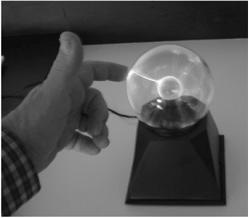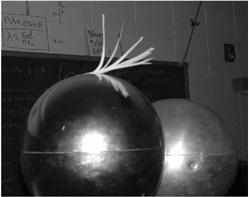125 Physics Projects for the Evil Genius (57 page)
Read 125 Physics Projects for the Evil Genius Online
Authors: Jerry Silver

where
k
is the Coulomb constant = 9.0 × 10
9
m
2
/C
2
.
Finding how many electrons are on a charged balloon.
Hang two balloons after first determining their mass. Charge them and touch them together, so they have roughly the same charge. The Coulomb force results in the balloons repelling and separating, as shown in
Figure 96-3
.
The number,
n
, of electrons on each of the balloons can then be determined from:

where
q
is the charge on 1 electron
= 1.6 × 10
−19
C
k
is Coulomb’s constant = 9.0 × 10
9
m
2
/C
2
m
is the mass of each balloon
and θ is the angle the string of each balloon makes with a vertical line.

Figure 96-3
Two balloons with like charges repel
.
The Coulomb force can also be explored in the following simple demonstrations:
A charged rubber rod, such as the one previously used to charge the pith balls, induces a current in a can. This enables you to roll the can back and forth across the table, as if the rod were a magic wand.
A thin stream of water from a facet can be bent by a charged rod.
The simplest of all is to take some transparent tape and adhere it to a table. After pulling it up, the tape will have acquired a charge that will be attracted or repelled by other nearby objects. Two similar pieces of tape acquire similar charges and are, therefore, repelled.
This is a true “evil genius” prop that looks like something out of a Frankenstein movie. A small
tesla coil
produces a large voltage difference
inside a glass bulb. This is similar to the way that charge builds up in clouds. Mini lightning bolts discharge through an inert gas in the bulb, producing an eerie glow. The electrons in the gas flow to the electrical ground harmlessly provided by a finger touching the outer edge of the glass as if the person touching the outside of the globe was a human lightning rod. This is safe to do because the current (amps) flowing is very small. See
Figure 96-4
.
Apply an Excel curve fit for the graph of the separation from equilibrium,
x
, versus the separation (d + x) between the balls. A scatter plot with the power option selected should indicate the best fit closest to –2, which is an inverse square relationship.
You could also plot
x
versus 1/(d + x)
2
. A linear fit to this graph would indicate an inverse square relationship between
x
(which is an indicator of the magnitude of the force) and
d
.

Figure 96-4
Plasma globe
.
The force between two charges is directly proportional to the product of the charges and inversely proportional to the distance separating the charges as given by Coulomb’s law.
Making lightning. The van de Graaff generator
.
A
van de Graaff generator
builds up static electric charges, which when discharged, produce visible lightning-like sparks. This is one of the more memorable physics experiments and provides a great introduction to the basic ideas of electricity.
- van de Graaff generator
- grounding sphere
- grounding wire—with alligator clip terminations or just plain insulated wire with the ends stripped
- confetti, paper holes from a hole puncher, Rice Krispies
- strips of paper
- scotch tape
- a few aluminum pie pans (the small ones that are about 4 inches in diameter are preferable)
- electroscope
- glass rod and silk, rubber rod, and wool or fur
- short (12 inch or so) neon light bulb
- insulated (plastic) crate
- other van de Graaff toys: spinner, spark gap
- electroscope
When used as intended and according to manufacturer’s specifications, this is a safe experiment. The van de Graaff generator produces high voltages. These can be over 20,000 volts, which may sound high. However, similar voltages are produced by scraping your shoes across a carpet on a day of low relative humidity. The voltage is high, but the current is very low, so the high voltage is not hazardous because very few electrons are involved.
Remove all electrical devices from your pockets or wrist. Set up a safe area with unobstructed access to the van de Graaff generator.
Here are some considerations:
- Sparks can damage electronic devices, including cell phones, audio devices, calculators, computers, digital watches, and pacemakers.
- This activity is fun because of the dramatic and sudden static electric discharges. However, make sure no one is put at risk by anyone’s sudden reactions to this apparatus.
- Be careful not to build up higher-than-intended charges using long human chains or other storage devices, such as capacitors or Leyden jars.
- Make sure sparks are not near flammable materials, such as natural gas pipes or combustible laboratory chemicals.
- Place the van de Graaff generator on a table and plug in the electrical chord.
- Position a grounding electrode a few centimeters from the conducting sphere of the van de Graaff generator. If you don’t have a discharge sphere purchased for this purpose, you can improvise using a metal rod, such as a ring stand.
- Attach a wire between the grounding electrode and an electrical ground, such as a water pipe or a metal beam that is part of the building structure.
- Turn on the van de Graaff generator.
- Darken the room.
- Move the conducting sphere of the van de Graaff generator back and forth, and observe what is the maximum distance a discharge will cross.
- Place a sheet of paper in the path of the spark. Does a sheet of paper stop the spark?
- Turn off the generator and touch the grounding sphere to the conducting sphere of the van de Graaff generator to remove any residual charge.
- Ground the conducting sphere.
- Use tape to attach strips of paper to the top of the conducting sphere of the van de Graaff generator.
- Turn on the generator and observe the paper hairs separating and standing on end, as shown in
Figure 97-1
. - Turn the generator off and ground the conducting sphere with the ground electrode to remove any residual charge.
- Ground the conducting sphere.
- Place an insulating surface on the floor near the van de Graaff generator. An inverted plastic crate works well for this purpose. The reason for doing this is to make sure no discharge occurs to conductors, such as water pipes, under the floor.

Figure 97-1
Like charges repel, causing the pieces of paper to separate
.
- Place your hand on top of the generator with the palm of your hand face down.
- Have someone turn on the generator. You can do it yourself, but be prepared for the possibility of a mild and harmless shock.
- This works best with people with long, fine hair on low humidity days. If someone comes close, they could be mildly shocked.
- When you are finished, turn off the van de Graaff generator, step off the crate, and discharge the conducting sphere.
- Ground the conducting sphere.
- Place an aluminum pie tin on the conducting sphere.
- Turn on the generator and observe the result.
- Try this with several pie pans stacked on top of the conducting sphere.
- Turn the generator off and ground the conducting sphere with the ground electrode to remove any residual charge.
?
- Ground the conducting sphere.
- Turn on the generator and bring the electroscope near the conducting sphere. Don’t be totally surprised if you get a spark.
- Rub the glass rod with the silk to produce a negative charge on the glass rod.
- Bring the negatively charged glass rod to the top of the electroscope to separate the leaves.
- Bring the negatively charged electroscope near the van de Graaff generator and observe whether the leaves separate further or move closer together.
- Rub the rubber rod with the wool (or fur) to produce a positive charge on the glass rod.
- Bring the positively charged rubber rod to the top of the electroscope to separate the leaves.
- Bring the positively charged electroscope near the van de Graaff generator and observe whether the leaves separate further or move closer together.
- Based on the response of the electroscope, what do you conclude about the type of charge produced on the conducting sphere of the van de Graaff generator?
1. Turn on the van de Graaff generator.
2. Darken the room.
3. Bring a small neon bulb (with no electrical connections to either end) near the conducting sphere. If you get too close, some sparks will likely discharge harmlessly in your hand. If you prefer for this not to happen, you can rig up a nonconducting holder to support the neon bulb during this exercise. Be careful to avoid sudden moves that might result in dropping the bulb.